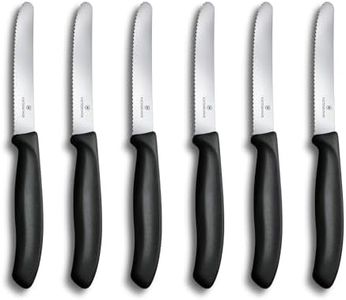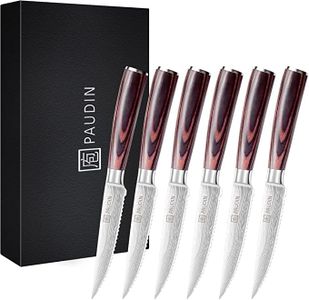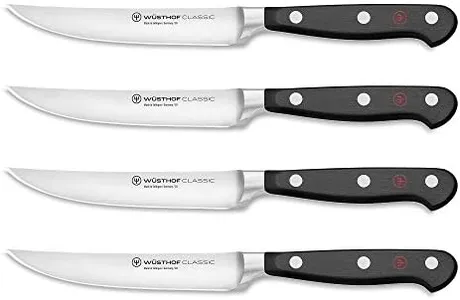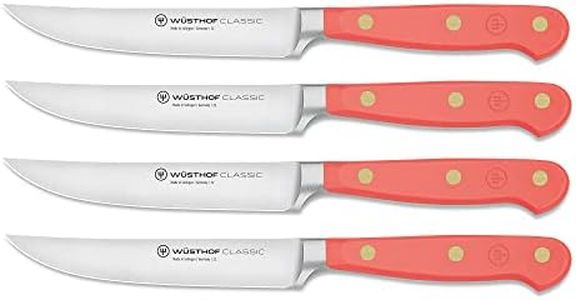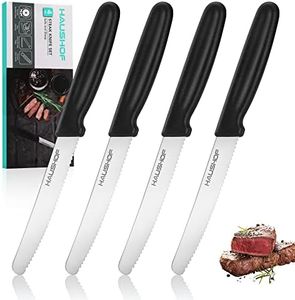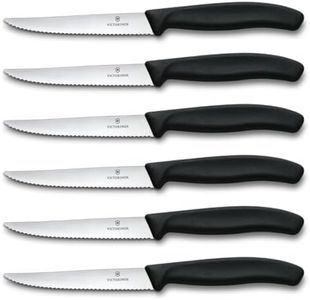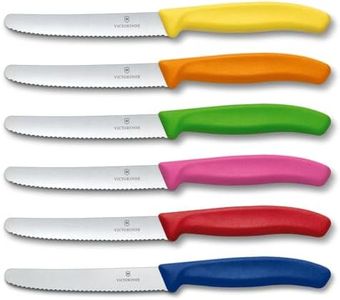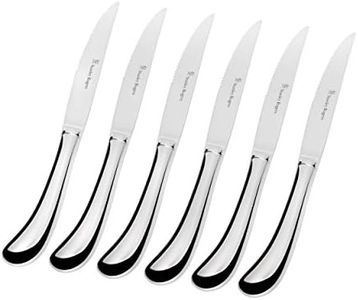We Use CookiesWe use cookies to enhance the security, performance,
functionality and for analytical and promotional activities. By continuing to browse this site you
are agreeing to our privacy policy
10 Best Steak Knives Sets
From leading brands and best sellers available on the web.Buying Guide for the Best Steak Knives Sets
Choosing the right steak knife set makes mealtime more enjoyable and can elevate how you experience your favorite cuts of meat. Good steak knives cut cleanly, feel comfortable in your hand, and stay sharp for a long time. When you're shopping, it's smart to look beyond just the way the knives look—pay attention to important features that affect performance, comfort, and durability. Thinking about who will use them, how often you'll use them, and how much care you're willing to give can help you pick the set that’s best for you.Blade Type (Serrated vs. Straight Edge)Steak knives come with either a serrated or straight edge blade. Serrated blades have a saw-tooth edge that can slice through tougher or crusty exteriors, like grilled steak, without requiring frequent sharpening. Straight edge blades, on the other hand, deliver cleaner cuts and can slice meat more precisely, but they do need sharpening more often. If you want low maintenance knives and cut a lot of charred or tough meats, go with serrated edges. If you prefer a finer, restaurant-like cut and don't mind sharpening your knives periodically, straight edges could be better for you.
Blade MaterialSteak knife blades are most commonly made from stainless steel, carbon steel, or sometimes high-carbon stainless steel. Stainless steel is popular because it resists rust and requires little upkeep, making it a solid all-around choice. Carbon steel holds a sharper edge for longer, but it can rust if not dried after washing. High-carbon stainless steel blends the best of both, staying sharp and resisting stains. If you want easy care, look for stainless or high-carbon stainless steel. If you're happy to give knives a bit more attention, consider carbon steel for superior sharpness.
Handle Comfort and MaterialHandles can be made from wood, plastic, or metal, and their shape affects how comfortable they feel in your hand. Wood handles are traditional and have a classic look, but need gentle washing and occasional oiling to prevent cracking. Plastic handles are lightweight and easy to clean, but may not last as long. Metal handles are durable and usually dishwasher safe, but can feel cold or slippery. Try to pick a handle that feels stable and comfortable, especially if you’ll be using your knives often or have large or small hands. Test holding similar handles if you can—comfort makes a big difference.
Construction (Full Tang vs. Partial Tang)The 'tang' is the part of the blade that extends into the handle. Full tang knives have the blade metal running through the entire handle, which makes them stronger and better balanced. Partial tang knives have the blade going only partway into the handle, which can make them less sturdy. Full tang construction is preferred for durability and a solid feel, so choose it if you plan to use your knives frequently or want them to last for many years. Partial tang can be sufficient for occasional or casual dining.
Number of Pieces in the SetSteak knife sets can come in various sizes, commonly ranging from four to twelve or more knives per set. How many you need depends on your household size and how many people you serve at once. For singles or couples, a smaller set might do, while families or those who entertain guests regularly may want a larger set. Think about your typical meal gatherings—it's always better to have a couple of extra knives than to run short when hosting.
Ease of Care and MaintenanceSome steak knives can be put in the dishwasher, while others need to be washed by hand. Wood and certain high-quality knives can be damaged by dishwashers, while plastic or metal handles tend to be dishwasher safe. Consider how much time and effort you want to spend on cleaning—if convenience is key, check for dishwasher-safe options, but always follow manufacturer instructions to keep your knives in top shape.
Weight and BalanceThe weight and balance of a steak knife affect how easy and pleasant it is to use. Heavier knives can feel more substantial and sometimes offer better control for thick cuts, while lighter knives may be easier for some people to handle. Balance refers to how the weight is distributed between blade and handle—a well-balanced knife feels stable and comfortable, making cutting smoother. If unsure, try holding knives to see which feels best in your hand. Your own comfort and cutting style should guide your choice.
